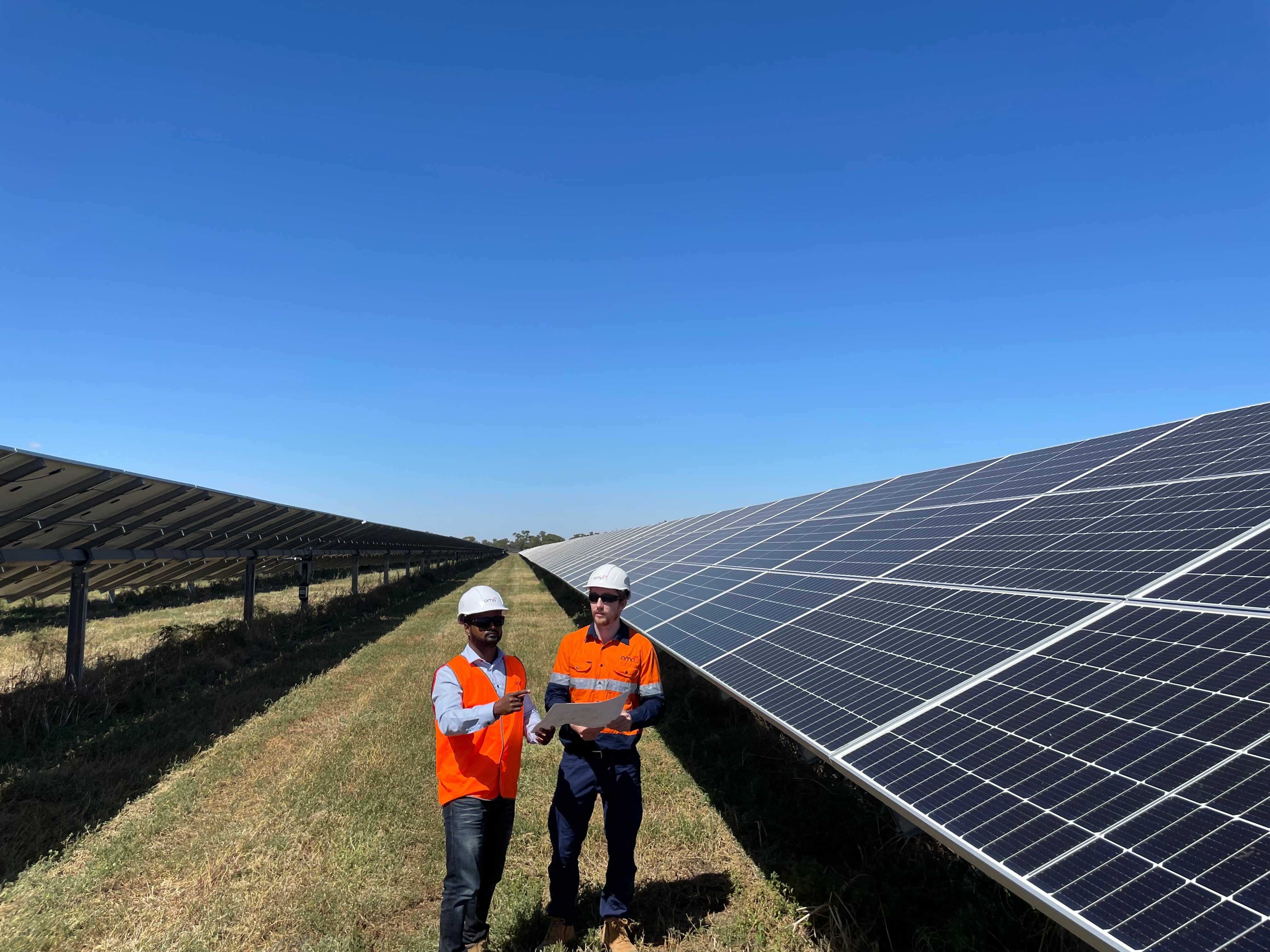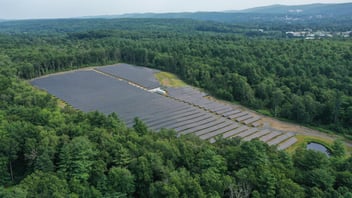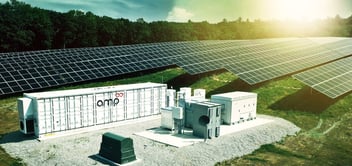Exploring the Renewable Energy Development Cycle - Jared Donald, Head of US Operations


Renewable energy development can be a long and complicated process, but for Amp Energy’s Executive Vice President and Head of US Operations, it's also an opportunity to build stronger local communities.
Having successfully weathered the COVID-19 storm, the US renewable energy industry is now gearing up for a decade of unprecedented growth. Across the country, over 60 GW of solar and wind generation is projected to come online by the end of 2022.
For Jared Donald, a 15-year industry veteran overseeing Amp’s US operations, the renewable development cycle is both challenging and rewarding. “It’s an extremely nuanced, detail-based business, and it’s continuing to grow in complexity,” he said. “There are many different individuals, stakeholders, and government bodies involved throughout the process, each of which can influence the entire project. But despite these challenges, there are also many tremendous opportunities.”
From the outside looking in, it can be easy to assume renewable energy projects involve a handful of meetings, some official signatures, and a few months of construction. But in reality, they often take between three and five years to reach completion, meaning there are many in planning today that won’t begin operation until the second half of the decade. With the US now rapidly accelerating its decarbonization efforts, renewable energy projects are not just delivering clean energy to local communities, but a host of other long-term economic and environmental benefits.
The Components of Renewable Development
There are four key stages in progressing a large-scale solar, wind, or battery storage installation from concept to construction, each of which require unique approaches and considerations.
Assessing Land and Network Availability
Traditionally, the first step of renewable energy development has been to identify, survey, and secure an appropriate parcel of land. But with utilities around the country now grappling with aging networks and capacity bottlenecks, Jared’s team has adopted a new strategy that has helped to streamline Amp’s development process.
“Years ago, you would just look for the best piece of land. Now, the biggest constraint we have in development is connecting the extra capacity to the grid,” he said. “So, we’ve adopted an interconnection-first approach to understand where the best connection points are within existing networks. It’s generally a binary outcome, so it allows us to put our time and energy into projects that have the greatest chance of success.”
Having identified a region with sufficient grid capacity, Jared’s team uses advanced soil mapping, wetland reviews, environmental reports, and topography models to create a shortlist of potential installation sites. “We’ll start with thousands of parcels and use screening to narrow it down to a few hundred that look promising. Once we’re down to those we’ve vetted for interconnection and environmental suitability, we’ll start reaching out to landowners to see if there’s interest in engaging in a development site.”
For many property owners, renewables are a welcome opportunity to convert underutilized land into secure, long-term income. With the growing popularity of both utility-scale and community solar farms, there’s generally no shortage of interested parties looking to work with a reputable developer.
Interconnection Approval From the Local Utility
With increasingly fierce competition in the renewable energy marketplace, developers now regularly find their projects waiting in network connection queues behind dozens or even hundreds of other applicants.
This trend is now on full display throughout the country, with a recent report by the Solar Energy Industries Association (SEIA) stating that the US currently has 1,400 GW of clean energy capacity awaiting interconnection to the grid.
“If you look at the queues across the United States, they’re very, very full,” Jared said. “And it’s definitely becoming more challenging as the volumes continue to increase.” And while not all projects that apply for interconnection approval reach construction, the growing volume of applications has led to waiting periods of more than two years.
Construction and Environmental Permits
After securing land interconnection request with the local utility, Amp then works through the process of gaining all legal and environmental approvals needed to commence construction. And whereas solar permitting was once a relatively straightforward process, Jared says there are many new challenges and considerations requiring a heightened commitment to detail.
“There’s a lot of focus from municipalities, especially as interest in development grows, to put more regulations and requirements in place. When solar was still in its infancy, I think there was less concern about where it went and how it was installed.”
Many rural towns in the US are run by volunteer boards of community members, and with a growing number of developers looking to secure prime real estate, Jared says application volumes are leading to considerable delays. “In some cases, they’ll put in moratoriums for six to twelve months just to work out what their permitting guidelines should be,” he said.
But Jared stresses that while permitting is becoming increasingly complex, it's primarily driven by an aim to secure high-end projects that deliver maximum value to the local community. “Solar is a huge economic benefit for the towns, both in job creation and tax revenues, so they’re certainly not opposed to it, they just want to make sure they get it right.”
Offtake Agreements With Customers or Utilities
The final step of the development process is securing off-takers for the electricity generated by the system, which ranges from project to project but are generally residential and small business customers, large companies, or the local utility. And as Jared explains, a key element of Amp’s strategy is not just to supply its customers with clean energy, but to develop broad-scale solutions that support their overall decarbonization efforts.
“A number of our off-takers are large corporations, and we want to be there to help them in other areas such as EV charging infrastructure, on-site battery storage, and other energy-efficiency and reduction plans. We think it’s critical to continue supporting a holistic approach to their overall energy transition.”
While commercial and utility off-takers are essential parts of Amp’s development projects, its largest client base consists of residential and small business customers. Through both partnerships and its internal resources, Amp has developed strong customer management capabilities and plans to continue nurturing these relationships as it seeks to maintain its market-leading service and support. Within this core customer group, Amp is also investing significant time and attention into supporting low- and moderate-income (“LMI”) customers, a critical policy driver accelerating the rollout of community solar programs across the US. Amp’s first LMI community solar projects were built in 2020, with more planned for this year.
The current shift towards decarbonization is also increasing the urgency not just for renewable energy, but energy in general. “The national move to electrification is going to continue to increase demand, and going forward, it's more likely to be served by low-emission sources than traditional thermal generators. So, for all of us here at Amp, it’s a very exciting time.”
The Importance of Strong Community Relationships
Having spent the last decade and a half working in renewable energy markets throughout Canada and the US, Jared understands the value of forging strong ties with local communities. And across all key stakeholders – including site developers, landowners, city officials, and electricity off-takers – Amp strives to create positive relationships that ultimately benefit the entire region.
A critical element of the process is selecting development partners with a keen attention to detail and a positive reputation in the local area. “A large portion of our asset base comes from working with local developers in the markets, operators that know their local community and have been involved there for decades,” Jared said. “And that’s been a fundamental aspect of our business ever since it started.”
“Whenever we can, we work with development partners that aren’t just tied to the local community, they’re already a part of it.”
In addition to engaging and supporting local developers, there’s also the need to build strong relationships with municipalities, particularly as there can be personnel changes during critical stages of the process. “In many cases, especially in smaller communities with volunteer boards that rotate on a regular basis, it becomes difficult to maintain consistency and process,” he said. “It’s not uncommon to have a planning board change over in the middle of our development cycle.”
To maintain consistent engagement and awareness, Jared’s teams work closely with local residents and officials through meetings, information sessions, and community outreach programs. “We do everything we can to understand their guidelines, engage with the communities, talk with the town planners, present different options, and talk about different solutions,” he said. “In my experience, the final installation is rarely, if ever, the same as the initial concept, and that’s why community engagement and involvement are such critical factors.”
But despite the challenges, Jared is committed to finding the best outcomes within each community and emphasizing Amp’s dedication to the project’s long-term success. “One of our key points of difference is that if something ever goes wrong, we’ll still be there to deal with it in five, ten, or fifteen years. So it’s critical for us to plan the projects correctly, engage all local stakeholders, and maintain those close relationships."
Making Beneficial Long-Term Investments
With an impressive 4.6GW of renewable energy developments either built or under contract globally, Jared says Amp is also a leader in terms of its financial and social commitments to each project. “For many developers, their focus is to go in early, find these opportunities, get them ready, and then sell them off at the start of construction,” he said. “One of the things we really focus on when we’re in communities, whether we’re there alone or with a development partner, is to ensure they understand we’re the long-term owner and operator of the project.”
While solar and wind farms are becoming familiar sights throughout the US, there are still varying levels of interest when it comes to developing land, even among neighboring property owners. “There’s such a wide spectrum of interest and attitudes towards renewables, even to generalize it down to an area within a single state would be impossible.”
“When approaching landowners, we hear everything from ‘No thanks’ to ‘Sure, come on in, what can I do to help?’”
Upon engaging an interested property owner, Amp then offers to lease or purchase the land for the installation. For many, it’s a welcome opportunity that can provide decades of financial security. “We’re looking to occupy the land for 40 or more years, because that’s how long these projects last. And for some landowners, that’s a great thing, because they can count on a long-term revenue source that’s a lot less variable than activities like farming,” he said.
For members of the broader community, renewable energy installations also have many other advantages that may not be apparent at first glance. In addition to clean energy and improved air quality, there are also benefits of higher tax revenues, increased local employment, and projects that are far less disruptive than other forms of energy generation. “A solar farm has no moving parts, makes next to no noise, and creates no gasses or emissions. So, from a development perspective, it’s one of the best neighbors you could ever have.”
Staying Ahead of Renewable Development Trends
With renewables achieving near exponential growth since 2009, Amp understands the importance of embracing new technologies and ensuring Amp stays at the forefront of innovation. And with America’s urgent need to both maximize clean energy generation and support its aging electricity infrastructure, battery storage is quickly becoming a critical piece of Amp’s future.
“Energy storage is completely changing how the grid is being conceived, managed, and upgraded.”
“We recently commissioned our first solar plus battery storage systems in the United States. We’re using the batteries to manage any excess production when the grid is already full, but it also helps us in the event of curtailment, and allows us to participate in utility services markets,” Jared said. “From a grid perspective, we’re now regularly seeing non-wire alternatives such as distributed solar energy and microgrids being proposed with battery storage, which is often cheaper and more effective than continually adding bigger poles and wires to the network.”
Another trend gaining significant traction is “agrivoltaics” - the fusion of agriculture and photovoltaics - which enables farmers to utilize their land for a solar installation while maintaining their farming activities. “We have sites in Massachusetts where there’s going to be an ongoing farming operation alongside the solar installation. These dual-use activities are something we’re very keen on, and we think they’re great community integrations that help support ongoing agricultural activities,” Jared said.
“We believe agrivoltaics is one of the keys to our nationwide success. It’s extremely popular with our stakeholders, and the ability to maintain farming operations can be the determining factor that moves a solar project forward.”
While these hybrid installations are more complex to plan and construct, Jared believes the combination of consumer demand and government support will help agrivoltaics emerge as a mainstream solution. “There’s very strong policy support for it in many states and a growing number of farmers that are interested in the idea. So we do believe it has an important role to play in the future of solar, and it’s something we’re going to be much more involved in going forward.”
Renewable Energy Projects That Give Back
In its mission to accelerate the US energy transition, Amp is also committed to promoting strong Environmental, Social, and Governance (ESG) standards at every stage of its operations. “We want to be strong stewards of the environment through these long-term projects and the further commitments we’re making to the towns,” said Jared.
Amp is an official signatory to the Task Force on Climate-Related Financial Disclosures and proactively incorporates ESG principles throughout the development cycle, covering areas such as environmental impact, local community engagement, and regulatory compliance. “Our business goes far beyond being a financier, owner, and operator of renewable energy assets, it also extends to promoting ESG initiatives that support our communities and corporate customers.”
As part of its sustainability report, Amp announced it would allocate a value of $15 per metric ton of its organizational carbon emissions (excluding suppliers) to invest in ecological and social initiatives throughout the communities where it operates. These programs include supporting pollinator fields and wetland conservation projects, aiding corporate customers with EV charging and energy efficiency, and investing money into community education.
“We have a number of projects in Upstate New York where we’re providing scholarships to both grade-school and post-secondary institutions that support STEM programs,” Jared said. “And we’ve also had development partners of ours to arrange school tours and educational programs to raise awareness about renewable energy within the community.”
In other instances, Amp has donated land back to the local municipality and then leased it during the project’s operation to support the region’s conservation efforts. “We have a project in Massachusetts getting ready for construction in which we’ve donated about 30 acres of land back to the town. They’ll own it, we’ll lease it back from them, and they’re going to put it into permanent conservation after the project is complete.”
For Jared and his US operations team, it’s clear that renewable energy is about more than simply reducing carbon emissions; it’s a powerful mechanism to drive social and environmental change.
“There’s significant momentum to accelerate investments in environmental justice, low-income areas, and programs that help to shrink the wealth gap. These initiatives are already creating many important opportunities, and will continue to do so,” Jared said.
“We need renewable energy to create a healthier climate, but increasingly, we need it to create healthier communities as well.”







